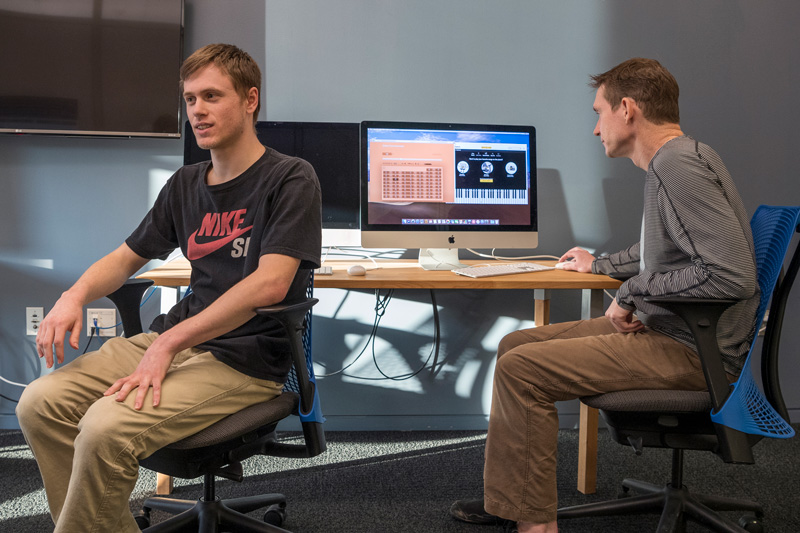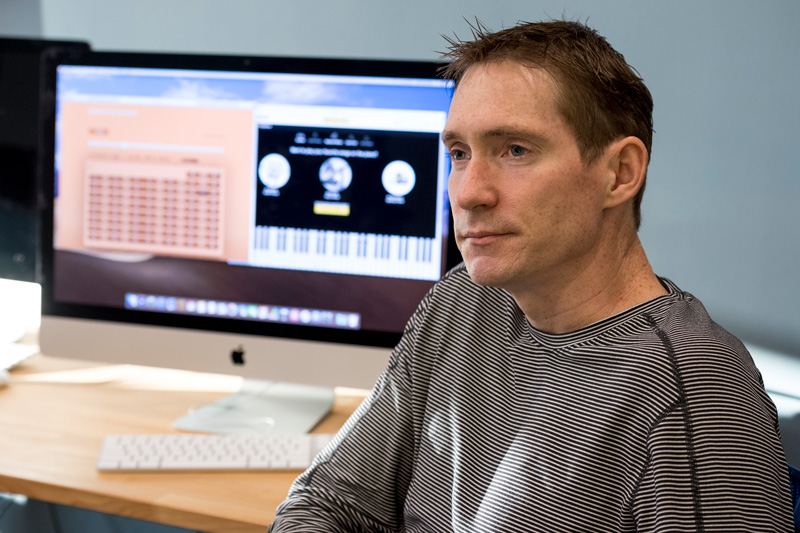

: youtube.com/watch?v=LmqOMK5dhyc
Pitch perfect neuroscience
Photos by Kathy F. Atkinson and courtesy of Larissa McKetton | Video by Lisa Tossey and Paul Puglisi February 11, 2019
UD’s Keith Schneider finds brain distinction in those with rare ability
Play a note, any note — on your piano, your harp, your synthesizer, your kazoo. University of Delaware junior David Krall can tell you exactly which note you’re playing and which octave it lives in.
He has perfect pitch — the mind-boggling ability to accurately identify a musical note without any other reference point.
Mere mortals such as us cannot grasp this. And scientists say it is rare indeed, occurring in just one in 10,000 people, a small subset that includes Bach, Beethoven, Mozart, pop singer Mariah Carey and, yes, Krall. (More on him later.)
We now know that the brains of this rare breed are different, too.
In research published Monday, Feb. 11 by the Journal of Neuroscience, University of Delaware neuroscientist Keith Schneider and collaborators at York University in Toronto, Ontario, show that the brains of those with absolute pitch — the more formal name of this ability — have a larger auditory cortex, a part of the brain that processes sound.

They also found that most of that extra territory is devoted to processing a broader band of frequencies, not a narrower band. The researchers suggest this may indicate a greater ability to use “ensemble coding,” in which networks of neurons with overlapping frequency ranges encode the musical note, instead of a smaller set of individual neurons.
Researchers do not know exactly why or how these differences occur, but they believe there may be genetic components and possibly environmental factors, too. There are siblings with perfect pitch, for example, and students in Suzuki music programs in Japan have shown a higher propensity for perfect pitch, Schneider said.
“One thing we didn’t determine is whether this larger cortex is a cause or an effect,” he said. “They could have had this from birth or it could be because they developed an enlarged cortex through training. We didn’t determine that. You’d have to do a longitudinal study over people’s lifespans.”
Does that mean you can learn perfect pitch? That is not settled science. Some try, but it may be an exercise in futility and may lead to unintended challenges.

Having perfect pitch may not be as desirable as you might think.
“If you talk to people with it, it’s not clear that it’s beneficial to them as opposed to distracting,” Schneider said. “Whether it’s good or bad depends on who you talk to.”
About the study
The work was done at York University in Toronto, Ontario, where Schneider was on the faculty before he became director of UD’s Center for Biomedical and Brain Imaging (CBBI) in 2016. Larissa McKetton, lead author of the journal article, was a doctoral student in his lab and the research was part of her dissertation project. Also contributing was Kevin DeSimone, another of Schneider’s doctoral students, who wrote the software code, helped analyze data and develop components of the experiment.
“I’ve always been fascinated about absolute pitch,” said McKetton, who in addition to being a neuroscientist is a pianist, vocalist and composer in her own right. “What is so special about those who possess absolute pitch is their ability to perceive a note or collection of notes and recreate them in the absence of a reference tone. My interest in neuroscience and neuroimaging allowed me to dig deeper into the neural correlates and mechanisms that can underlie this ability that hasn’t been done before.”
Sixty-one people participated in the study – 20 with absolute pitch, 20 trained musicians who do not have absolute pitch and 20 who had little or no musical training. One musician was an outlier, and was not included in the study results. This musician had what is known as quasi-absolute pitch — absolute pitch for only one note, middle C — and could identify most notes relative to that.
Those with perfect pitch identified randomly generated tones with 100 percent accuracy. The outlier was about 67 percent accurate. The rest of the participants did as well as random chance, about 8 percent accurate.

All participated in functional magnetic resonance imaging (fMRI) brain scans. The information captured there was mapped and analyzed with computer modeling.
A bit of anatomy may be helpful here. The brain processes sound in a small area called the auditory cortex. It is found along both sides of your head, just above your ears, in what is known as the temporal lobes.
The auditory cortex has regions of its own and scientists have plotted out “tonotopic” maps, meaning that the neurons are laid out in order of their best frequency response. These maps show where specific frequencies are processed within these regions.
The researchers found that all participants with perfect pitch had larger auditory cortical areas than the others. Other trained musicians and those in the control group had cortical areas that did not differ much in size from each other.
One surprise was that the larger auditory cortical areas were not used for sharper tuning, as researchers expected. Rather, those with perfect pitch used that extra territory for tuning a broader range of frequencies. Those kinds of measurements had never been captured before.
They also found evidence that argues against an often-discussed “critical period” theory that perfect pitch is possible only in people whose musical training begins before the age of 7. Several participants with perfect pitch had not started musical instruction until their late teens or even early 20’s, McKetton said. The vast majority of musicians do not have perfect pitch despite thousands of hours of training and practice.
It is not known if someone with zero musical training could have perfect pitch. Certainly, they couldn’t call out the notes if they have had no music theory. But it might be possible to test their ability to identify frequencies, Schneider said. That was not part of this research.
There is a range of capacity, too. People with perfect pitch can identify the note almost instantly and some of them can also identify the frequency. For example, they could say “A4” — the note “A” in the fourth octave — and they could also say “440 Hertz,” the precise modern-day frequency for that note.
There are other fascinating twists to all of this.
When Schneider’s 14-year-old son, Felix, heard about this research he told his dad he had perfect pitch. When Schneider tested him, though, he got every note wrong — until they adjusted the results for someone who plays the trumpet, as Felix does. Trumpets are tuned one whole step differently than pianos. So playing a “C” on the trumpet is the same as playing a “B-flat” on the piano. When Felix made that one-step correction in his answers, he was 100 percent accurate. He has perfect pitch.
In another study McKetton did, a 70-year-old man said he had perfect pitch but got every note wrong when he was tested. She then noticed that all of his responses were one tone off. The perceptual change in pitch may have been due to age-related changes in the stiffness of the basilar membrane within the cochlea of the inner ear, she said. When she asked him to adjust his answers by one tone, he was 100 percent accurate.

Most musicians who do not have perfect pitch do have relative pitch, Schneider said. They can tell you a note or an interval based on its relation to another note. McKetton has that ability herself.
A bane and a blessing
Perfect pitch is rare, but it’s not always a wonderful gift. Off-key voices and out-of-tune instruments can drive these human tuning forks to distraction.
When a group starts singing “Happy Birthday,” for example, Krall, the UD junior from Hockessin, Delaware, usually takes a pass. The discordant mixture of keys that usually emerges makes his ears curl.
He is not a music major but enjoys making music. A tenor, he sings with the Golden Blues, UD’s a cappella group.
Krall said he had no idea what perfect pitch was until he was a teenager and heard his girlfriend singing a Fleetwood Mac song. He commented on her range and named the note that especially impressed him. She asked if he had perfect pitch and he shrugged. Who knows?
The choir teacher later put him to the test with her piano and pronounced him pitch perfect.
On Feb. 5, Krall visited CBBI where Schneider tested him, using computer software to produce a random series of notes, with a wide range of frequencies.
He answered fluently.
“C-sharp 4.”
“A 4.”
“D 3.”
“A-flat 4.”
“E.”
And on and on, one note after another, from 40 Hertz to 8,000 Hertz — spot on, 100 percent accurate, perfect pitch.
“He’s got it,” Schneider said.
And if Krall didn’t seem terribly impressed with himself — well, why would he? He used to think everyone had this ability.
“That’s how it works,” Schneider said. “If you look at a color you can say ‘blue.’ And that’s the same thing he’s doing with sound. He has the same association with sound that you would with color.”
Notable brain power.
Contact Us
Have a UDaily story idea?
Contact us at ocm@udel.edu
Members of the press
Contact us at 302-831-NEWS or visit the Media Relations website

